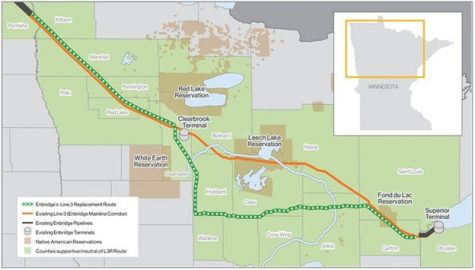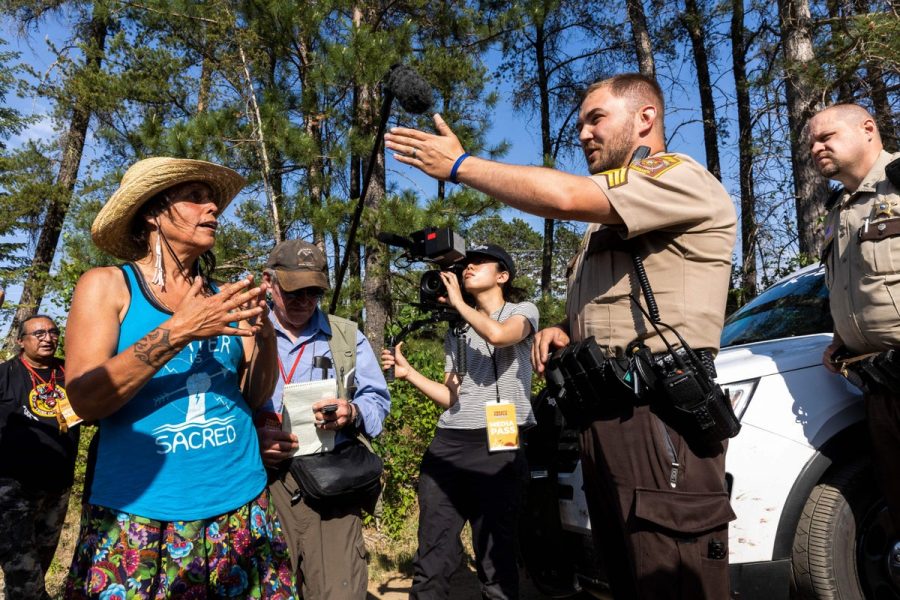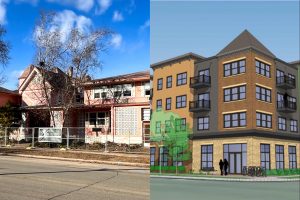Explained: The significance of the Line 3 pipeline protests in Minnesota
Activist Winona LaDuke at Line 3 construction site in Hubbard County, Minn. Retrieved from Getty Images.
August 27, 2021
On Wednesday, Aug 25, thousands of people took to Minnesota’s state capitol to protest the expansion of new oil pipeline Line 3. As of Aug 10, 2021, more than 600 people have been arrested for protesting the construction.
Protests against this expansion have occurred since the beginning of construction in 2017. People across the nation are still traveling to northern Minnesota—where current construction of Line 3 is taking place and majority of the pipeline resides–with intent to protest.
Canadian oil pipeline company Enbridge is behind the construction of the new pipeline. The current Line 3 was built in 1961 and is 1,097 miles long, stretching from Edmonton, Alberta, Canada to Superior, Wis.
Due to its age, the pipeline is corroded and has many leaks and cracks. The corrosion has led to several oil spills, including an approximately 1.7 million gallon spill into Minnesota’s Prairie River in 1991. Line 3 has had 14 major spills since then.
Enbridge’s data suggests that the pipeline has ten times as many corrosion anomalies than the company’s other existing pipelines. “They estimate over half a million structural anomalies in Line 3, which is about one every ten feet.”
Despite Line 3 being the most corroded pipeline in Enbridge’s mainline system, other pipelines show signs of corrosion anomalies. Enbridge is responsible for the 2010 spill into the Kalamazoo River, caused by a large crack in the company’s Line 6B pipeline.
In response to the condition of the now 60-year-old pipeline, Enbridge made plans for the construction of a new pipeline in a project titled “Line 3 Replacement Project”. Construction officially began in 2017. Construction in Minnesota started in December 2020 after approval from the state’s Public Utilities Commission.
Unlike the project title suggests, current construction of the new Line 3 is not actually replacing the old pipeline. Construction for the project has created a new corridor for the pipeline and as of now, the old Line 3 remains in the ground.
While it will be decommissioned, it is currently unclear whether Enbridge will have it removed or if the company intends on leaving the unused pipeline alone. United States law and Minnesota law both have unclear regulations for the removal of abandoned pipelines, so it is legal for Enbridge to leave the pipeline behind.
If abandoned, the pipeline may be the cause of several financial and ecological risks. The soil and water near the pipeline may become decontaminated due to residual oils and chemicals. By potentially abandoning the pipeline, Enbridge could risk creating a water conduit which will lead to the unnatural drainage of bodies of water and the incidental imbalance of the surrounding ecosystems.
Social movement Honor the Earth has also expressed fears that no one will be held accountable for possible contamination if stricter laws are not put in place.
Talks of putting a “landowner choice” program have been made, but there is no official plan of action. The program would allow those who own the land Line 3 runs through to decide whether they want the decommissioned pipeline to be removed.
According to Enbridge, the Line 3 Replacement Project will bring about 8,600 jobs to Minnesota, a $2 billion boost to Minnesota’s economy, provide greater support for Minnesota’s refineries and other benefits.
However, the increase in jobs comes with potential risks. The Stop Line 3 movement notes that the project will provide temporary housing for predominantly male workers and these housing sites may cause an increase in drug and sex trafficking. “The result is often devastating for women, children, and Two-Spirit people in nearby communities and in the international sex trafficking industry that feeds them. This is one of the many causes of the epidemic of Missing and Murdered Indigenous Women (MMIW), of which Minnesota and neighboring regions are some of the hardest hit.”
Pipeline protesters also fear that there will be overwhelming environmental impacts caused by the new construction. Once finished, the pipeline will transport about a million barrels of tar sands each day. Tar sands, a fossil fuel, are regarded by National Geographic as one of the most destructive oil operations in the world.

The use of fossil fuels for the pipeline could contribute to the ongoing climate crisis and will adversely affect Indigenous communities.
Indigenous people rely heavily on natural resources for survival. For example, wild rice or manoomin is culturally and economically significant to the Anishinaabeg. The new Line 3 would affect about 389 acres of wild rice beds.
There are over 180 sacred sites in the Line 3 impact zone which belong to the Anishinaabeg and other groups such as the Dakota and the Lakota. The state of Minnesota was obligated to archaeologically survey these sites for cultural traditions and resources but failed to do so.
Enbridge addressed some of these concerns. “In total, 15 locations [sacred sites] were recommended for avoidance and Enbridge committed to avoid the resources and developed avoidance measures at each location.” Enbridge’s exact action steps for avoidance measures are unclear.
Over the course of several years of Line 3 protests, protestors have reported police utilizing pepper spray and rubber bullets at pipeline construction sites. People who were arrested for protesting also noted that jail conditions were poor; police reportedly denied people medications and did not provide sufficient meals.
In April of this year, Star Tribune reported that Enbridge is funding the policing at their Line 3 construction sites. Wages, training, and equipment are covered by the company’s payments.
Besides protests, donations and other actions, support for the Stop Line 3 movement has also been shown through musical performances. On Wednesday, Aug 18, artists such as Eau Claire’s Bon Iver performed in Duluth, Minn. The benefit concert was hosted by activist Winona LaDuke and proceeds went to Honor the Earth. The concert was live-streamed and recorded.
To this day, people are continuing to challenge the Line 3 Replacement Project by signing petitions, writing letters, and divesting from banks, organizations and businesses.
To learn more about Line 3 and the communities that it’s affecting, visit Honor the Earth and Stop Line 3.







